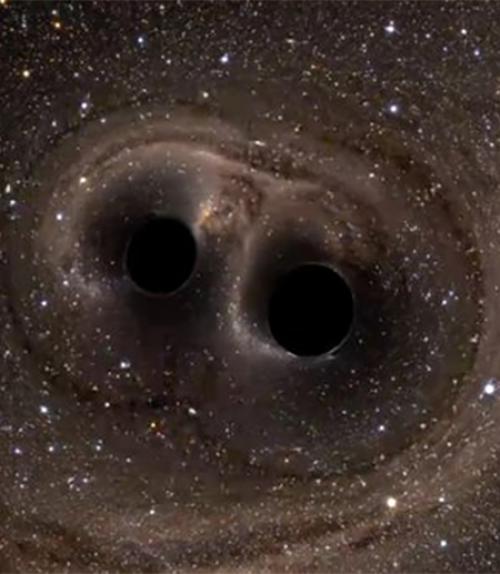Shoot a rifle, and the recoil might knock you backward. Merge two black holes in a binary system, and the loss of momentum gives a similar recoil -- a “kick” -- to the merged black hole.
“For some binaries, the kick can reach up to 5000 kilometers a second, which is larger than the escape velocity of most galaxies,” said Vijay Varma, an astrophysicist at the California Institute of Technology and an incoming inaugural Klarman Fellow at Cornell University’s College of Arts & Sciences.
Varma and his fellow researchers have developed a new method using gravitational wave measurements to predict when a final black hole will remain in its host galaxy and when it will be ejected. Such measurements could provide a crucial missing piece of the puzzle behind the origin of heavy black holes, said Varma, as well as offer insights into galaxy evolution and tests of general relativity. He is lead author of “Extracting the Gravitational Recoil from Black Hole Merger Signals,” published March 13 in Physical Review Letters and co-authored with Maximiliano Isi and Sylvia Biscoveanu of the Massachusetts Institute of Technology.
This simulation shows the merger of a 35 solar-mass black hole with a 25 solar-mass black hole, followed by the recoil (kick) of the final black hole. The movie is sped-up after the merger to highlight the kick. The arrows indicate the spins (rotation) of the black holes—these interact with the orbital angular momentum (pink arrow), causing the orbital plane to wobble as the binary evolves. The blue and red orbs indicate patterns of gravitational waves generated in the collision. Credit: Vijay Varma
As black holes orbit in a binary system, their gravitational waves carry away energy and angular momentum, which causes the binary system to shrink as it spirals inward. When a system has asymmetries, such as unequal masses, gravitational waves aren’t emitted equally in all directions, which causes a net loss of linear momentum, resulting in a recoil. Most of that recoil happens right near the merger which can result in a kick great enough to extract the newly merged black hole from its host galaxy.
The researchers’ models are based on supercomputer simulations that numerically solve Einstein’s equations of general relativity. The simulations were performed as part of a larger research effort under the Simulating eXtreme Spacetimes (SXS) Collaboration that includes research groups from Caltech and Cornell. Saul Teukolsky, Cornell’s Hans A. Bethe Professor of Physics, serves as the group leader.
“This research shows how gravitational wave signals can be used to learn about astrophysical phenomena in an unexpected way,” said Teukolsky. “It had been believed that we would have to wait more than a decade for detectors sensitive enough to do this kind of work, but this research shows we can in fact do it now - very exciting!”
While the existing publicly available gravitational wave signals announced by LIGO and Virgo were not strong enough for a good recoil measurement, according to the authors as these detectors improve over the next few years this method will be able to reliably measure the kick.
The research was made possible by support from the National Science Foundation, the NASA Hubble Fellowship and the Sherman Fairchild Foundation.






